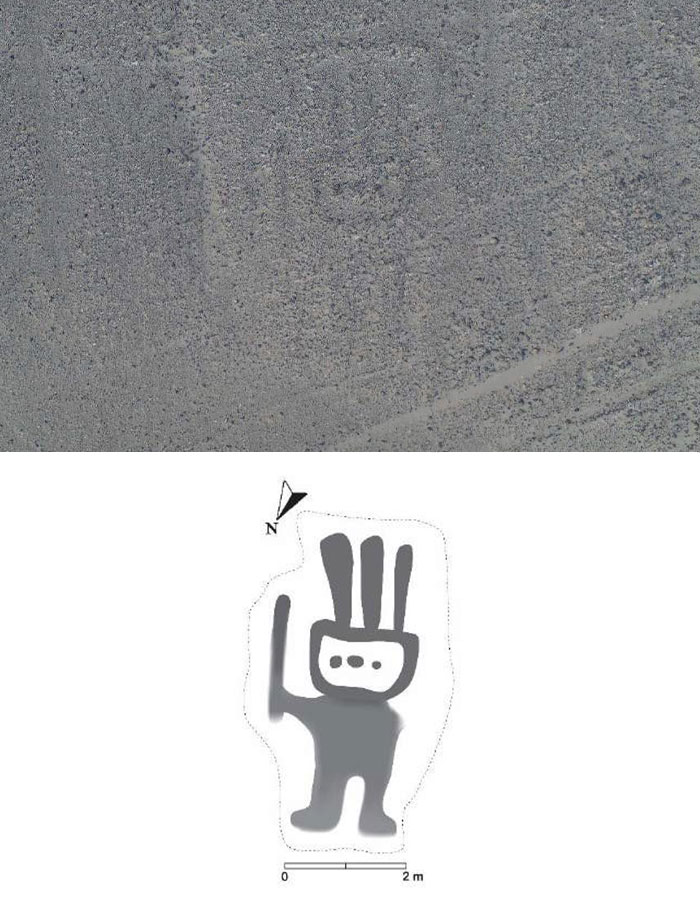
Team Of Scientists Discovered 140 Huge Mysterious Drawings In Peru
Humanity has come a long way with its numerous discoveries throughout history. Everything from new locations to new species to new technologies, history is chock-full of notable findings and breakthroughs.
However, the universe is infinitely vast, so the journey never stops and there’s always something new to find. In fact, you’d be surprised how tremendously little we know about our own planet. The fact that we’ve only explored around 5% of our oceans is proof of how much is still left to be discovered.
Scientists discovered over 140 new Nazca Lines, including this one—a bird
Image credits: Yamagata University
A team of Japanese scientists have found 143 new geoglyphs in the Nazca Pampa region, Peru. The team was lead by Cultural Anthropologist and Andean Archeology Expert Professor Masato Sakai of the Yamagata University.
Humanoid
Image credits: Yamagata University
Humanoid
Image credits: Yamagata University
The Nazca Geoglyphs (also known as Nazca Lines) are a group of very large glyphs impressed into the soil of the Nazca Desert in southern Peru. These depict a variety of animals, people, plants, among other things. The glyphs date back to some time between 500BC and 500AD and is a designated UNESCO World Heritage Site.
Double-Headed Snake & Person
Image credits: Yamagata University
Fish
Image credits: Yamagata University
One of the more interesting facts about the Nazca Lines is that they are extremely huge. The individual figures can span anywhere from 0.4 to 1.1 kilometers across, amounting to approximately 1,300 kilometers of lines covering around a 50-square-kilometer area.
Killer Whale
Image credits: Yamagata University
Humanoid
Image credits: Yamagata University
Professor Sakai and his team at Yamagata University began their studies back in 2004. Over the past 15 years, the team has identified numerous geoglyphs and has taken measures to preserve the heritage site. Factors like the expansion of urban areas has led to the damage of these lines, which drew gradual attention to the issue.
Mouse & Person
Image credits: Yamagata University
Human Neck
Image credits: Yamagata University
Besides carrying out extensive fieldwork and other activities, Sakai’s team analyzed a number of high-resolution 3D data. They have also managed to discover one more glyph by developing an AI model based on the AI server IBM Power System AC922 configured with the deep learning platform IBM Watson Machine Learning Community Edition. This led to the first geoglyph discovery by an AI in history.
Feline
Image credits: Yamagata University
Fox & Bird
Image credits: Yamagata University
A collaboration with IBM Japan will allow the science team to analyze and manage large complex data sets using AI. The new tech and efforts invested in the study will inevitably promote a greater understanding of the Nazca Lines in their entirety, and will boost the speed at which research of this heritage site is done.
Here is a video from IBM Research showcasing the newly found geoglyphs
Image credits: IBM Research
58Kviews
Share on FacebookBefore the internet people were already crazy about cat pictures it seems : )
Load More Replies...Just me ? Tipping my head over this-way that-way trying to see the first bird ?
Incredibly faint, and, oh yeah, who decides these? Look at them upside down. Seriously. BTW, these lines were made over a lon gperiod of time, and long ago, and for all we know, someone was giving the sky gods a big old raspberry, sooooo....
I've got one of the very first animals they made there tattooed on my inner right arm - the hummingbird.
Makes me wonder what other big discoveries are still out there, hiding in plain sight. I feel like, often times, we miss them because we simply don't know what we're looking for. Or we literally don't dig deep enough because we assume we've found all there is to find.
Or, they literally dug too much and accidentally defaced the lines!
Load More Replies...Before the internet people were already crazy about cat pictures it seems : )
Load More Replies...Just me ? Tipping my head over this-way that-way trying to see the first bird ?
Incredibly faint, and, oh yeah, who decides these? Look at them upside down. Seriously. BTW, these lines were made over a lon gperiod of time, and long ago, and for all we know, someone was giving the sky gods a big old raspberry, sooooo....
I've got one of the very first animals they made there tattooed on my inner right arm - the hummingbird.
Makes me wonder what other big discoveries are still out there, hiding in plain sight. I feel like, often times, we miss them because we simply don't know what we're looking for. Or we literally don't dig deep enough because we assume we've found all there is to find.
Or, they literally dug too much and accidentally defaced the lines!
Load More Replies...
 Dark Mode
Dark Mode 

 No fees, cancel anytime
No fees, cancel anytime 






























































196
55